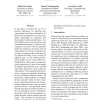Free Online Productivity Tools
i2Speak
i2Symbol
i2OCR
iTex2Img
iWeb2Print
iWeb2Shot
i2Type
iPdf2Split
iPdf2Merge
i2Bopomofo
i2Arabic
i2Style
i2Image
i2PDF
iLatex2Rtf
Sci2ools
EMNLP
2007
2007
Detecting Compositionality of Verb-Object Combinations using Selectional Preferences
In this paper we explore the use of selectional preferences for detecting noncompositional verb-object combinations. To characterise the arguments in a given grammatical relationship we experiment with three models of selectional preference. Two use WordNet and one uses the entries from a distributional thesaurus as classes for representation. In previous work on selectional preference acquisition, the classes used for representation are selected according to the coverage of argument tokens rather than being selected according to the coverage of argument types. In our distributional thesaurus models and one of the methods using WordNet we select classes for representing the preferences by virtue of the number of argument types that they cover, and then only tokens under these classes which are representative of the argument head data are used to estimate the probability distribution for the selectional preference model. We demonstrate a highly significant correlation between measures...
Distributional Thesaurus | EMNLP 2007 | Natural Language Processing | Selectional Preference Acquisition | Selectional Preferences |
Related Content
| Added | 29 Oct 2010 |
| Updated | 29 Oct 2010 |
| Type | Conference |
| Year | 2007 |
| Where | EMNLP |
| Authors | Diana McCarthy, Sriram Venkatapathy, Aravind K. Joshi |
Comments (0)

